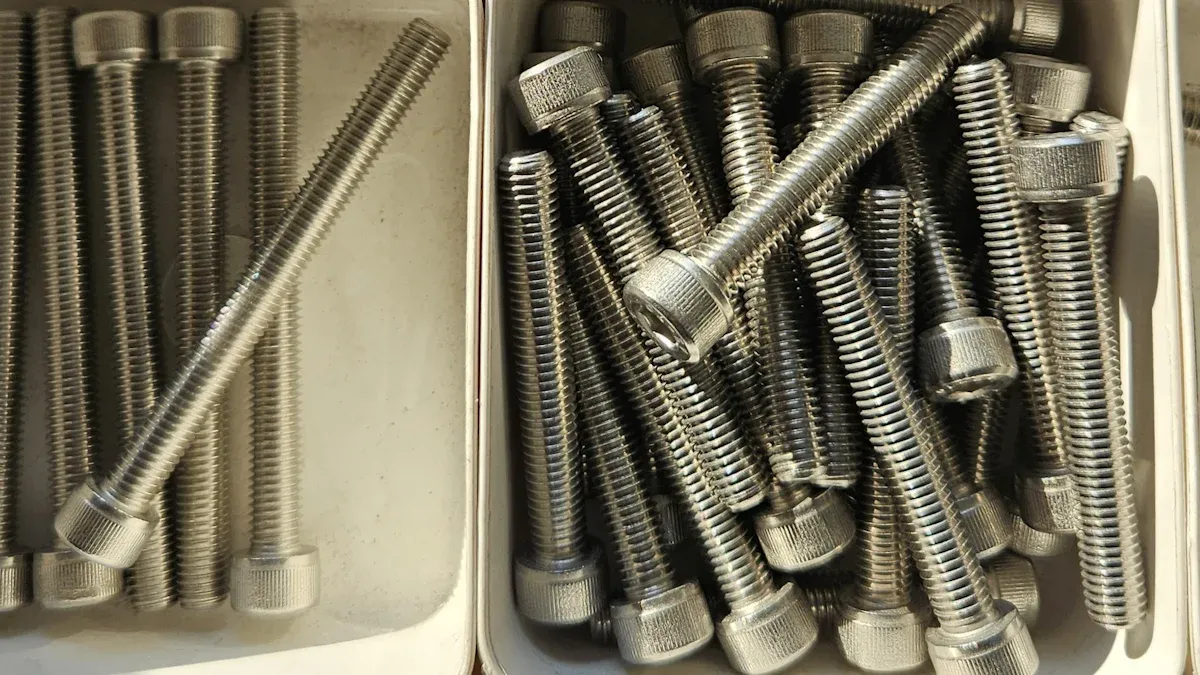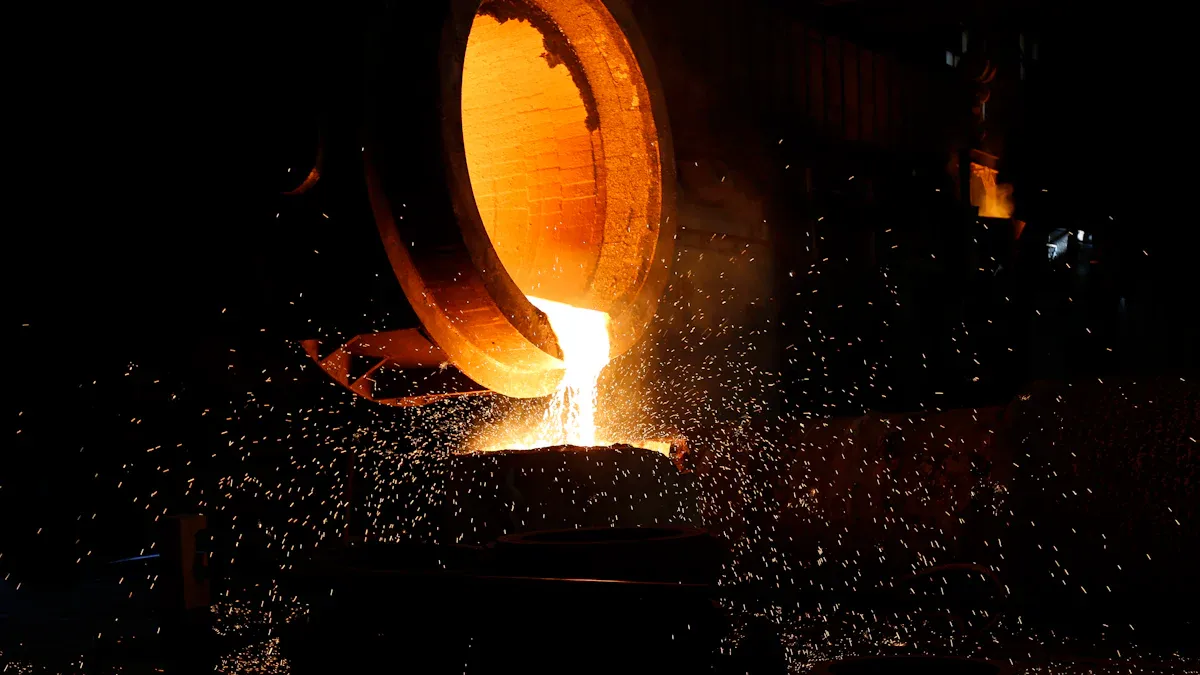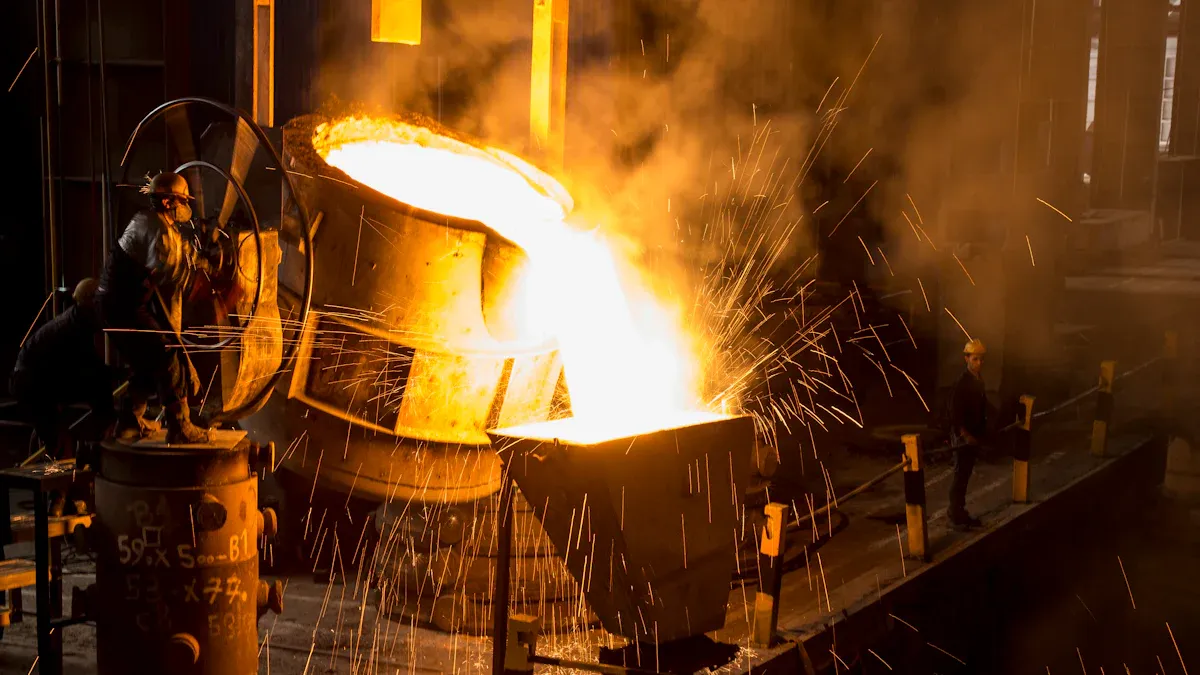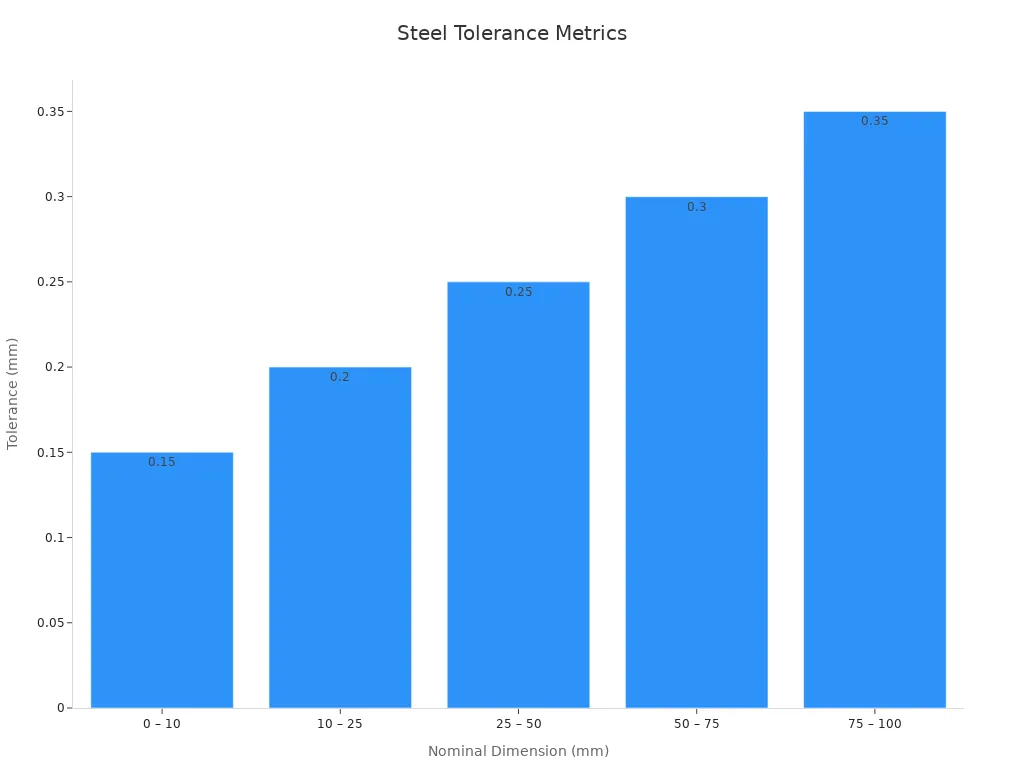Stainless steel precision castings for automotive parts

Stainless steel precision castings for automotive parts are essential in creating high-quality components. These castings involve shaping stainless steel into precise forms, ensuring accuracy and durability. Why does this matter? The automotive industry increasingly relies on these castings for their strength and resistance to corrosion.
- Market Size in 2023: USD 18.16 Billion
- Market Size by 2032: USD 29.48 Billion
- CAGR: 5.36% from 2024 to 2032
These numbers highlight the growing importance of stainless steel investment castings for automotive applications. As manufacturing technologies advance, demand for precision castings for automotive parts continues to rise, driving innovation and reliability in vehicles.
Key Takeaways
- Stainless steel castings are important for car parts because they are strong and resist rust, making cars safer and more reliable.
- This casting method makes detailed and complex parts, saving materials and lowering costs.
- Car makers now focus on being eco-friendly by using recycled steel and green methods in production.
Understanding Stainless Steel Precision Castings for Automotive Parts
The Precision Casting process explained
Precision casting, also known as Investment Casting, is a manufacturing process that creates highly accurate and detailed components. It starts with a wax model of the desired part, which is coated with ceramic material to form a mold. Once the mold hardens, the wax is melted away, leaving a cavity that is filled with molten stainless steel. After cooling, the mold is broken to reveal the finished part.
This process stands out because it achieves tight tolerances and intricate designs that other methods struggle to replicate. For example, components with fine undercuts, threads, or complex geometries are easily produced using precision casting. Additionally, the process minimizes material waste, making it an efficient choice for automotive manufacturers.
Tip: Precision casting is ideal for creating parts that demand both high accuracy and durability, such as engine components and exhaust systems.
Why stainless steel is ideal for precision casting
Stainless steel offers unmatched advantages for precision casting, especially in automotive applications. Its unique properties make it the go-to material for parts that endure extreme conditions.
Here’s a breakdown of why stainless steel excels:
| Attribute | Description |
|---|---|
| Corrosion resistance | Essential for fasteners in demanding environments. |
| Heat resistance | Outstanding performance at elevated temperatures. |
| Precision tolerances | Achievable tolerances not possible with other manufacturing processes. |
| High level of detail | Capable of producing fine undercuts and threads. |
| Superior surface finish | Achieves a finish as good as or better than machined parts. |
Automotive parts like exhaust systems and turbocharger housings benefit from stainless steel’s ability to withstand heat and resist corrosion. Comparative studies also show that stainless steel precision castings outperform conventional manufacturing methods in tensile strength and grain structure.
Key characteristics of stainless steel precision castings
Stainless steel precision castings combine durability, versatility, and aesthetic appeal, making them indispensable in various industries, including automotive. These castings exhibit several key characteristics:
- Valves and Pump Components: Used for critical components in fluid handling systems.
- Food Processing Equipment: Commonly found in hygienic applications due to corrosion resistance.
- Marine Hardware: Extensively used in environments resistant to saltwater corrosion.
- Architectural and Decorative Elements: Valued for aesthetic appeal and weather resistance.
- Medical Equipment: Essential for biocompatibility and sterilization in medical devices.
- Automotive and Aerospace Components: Important for strength and heat resistance in various parts.
- Industrial Machinery: Beneficial for durability and wear resistance in harsh conditions.
In automotive applications, stainless steel precision castings shine due to their ability to handle high stress, resist wear, and maintain performance under extreme temperatures. These qualities ensure reliability and safety, which are critical for modern vehicles.
Benefits of Stainless Steel Precision Castings in Automotive Applications
Durability and strength for high-stress components
Automotive parts often face extreme conditions, from high temperatures to intense mechanical stress. Stainless steel precision castings excel in these environments due to their exceptional durability and strength. These castings are engineered to withstand heavy loads and resist deformation, making them ideal for high-stress components like suspension systems, engine mounts, and drivetrain parts.
The inherent toughness of stainless steel ensures that these components maintain their structural integrity over time. This reliability translates to fewer replacements and repairs, which benefits both manufacturers and vehicle owners. By using stainless steel precision castings, automakers can enhance the safety and performance of their vehicles, ensuring they meet the rigorous demands of modern driving conditions.
Note: The ability of stainless steel to endure high stress without compromising performance makes it a preferred choice for critical automotive parts.
Corrosion resistance for extended lifespan
Corrosion is a major concern for automotive components, especially those exposed to moisture, road salt, and harsh chemicals. Stainless steel precision castings offer superior corrosion resistance, ensuring a longer lifespan for these parts. This resistance is achieved through a process called passivation, which creates a uniform oxide layer on the surface of the metal.
Key data supporting this claim includes:
- Passivation significantly extends the lifespan of metal parts by enhancing corrosion resistance.
- Stainless steel castings can withstand over 500 hours of salt spray testing (ASTM B117), demonstrating their ability to resist corrosion in harsh environments.
- These components often remain effective for several years, even in demanding conditions.
For automotive applications, this means parts like exhaust systems, fasteners, and brackets can maintain their functionality and appearance for extended periods. This durability reduces maintenance costs and enhances the overall reliability of vehicles.
Precision and efficiency in manufacturing
Stainless steel precision castings for automotive parts are not just about durability—they also bring unmatched precision and efficiency to the manufacturing process. The investment casting method allows manufacturers to produce complex geometries with tight tolerances, reducing the need for additional machining. This efficiency translates to faster production times and lower costs.
Studies have shown significant improvements in manufacturing performance when using precision casting techniques:
| Metric | Initial Value | Final Value | Improvement (%) |
|---|---|---|---|
| Good Parts Produced per Day | 390 | 600 | 53.85 |
| Overall Equipment Effectiveness | 42% | 81% | 92.86 |
| Productivity (Parts/hour) | 16.25 | 25 | 53.85 |
| Customer Claims per Month | 1.33 | 1.08 | 18.80 |
| Average Cost of Claims (€) | 465.5 | 378.0 | 18.80 |

These metrics highlight the efficiency gains achieved through precision casting. By minimizing material waste and streamlining production, manufacturers can meet growing demand while maintaining high-quality standards. This makes stainless steel precision castings a cornerstone of modern automotive manufacturing.
Applications of Stainless Steel Precision Castings in Automotive Parts

Engine components for enhanced performance
Stainless steel precision castings play a vital role in improving engine performance. Modern engines demand components that can handle high temperatures, intense pressure, and constant wear. Stainless steel excels in these conditions. Its strength and heat resistance make it ideal for parts like turbocharger housings, fuel injectors, and valve seats. These components must perform flawlessly to ensure the engine operates efficiently.
The precision casting process allows manufacturers to create intricate designs with tight tolerances. This means engine parts fit perfectly, reducing energy loss and improving overall performance. By using stainless steel precision castings for automotive parts, automakers can achieve better fuel efficiency and lower emissions. These benefits align with the industry's push for greener, more sustainable vehicles.
Exhaust systems for heat and corrosion resistance
Exhaust systems face some of the harshest conditions in a vehicle. They must endure extreme heat, corrosive gases, and fluctuating temperatures. Stainless steel precision castings provide the durability and resistance needed to meet these challenges.
- In the 1960s, corrosion in exhaust systems caused an estimated $500 million in losses.
- Corrosion occurs due to acids from fuel combustion and temperature changes.
- Tests, such as acid condensate exposure and field trials on prototype mufflers, confirm stainless steel's superior performance.
These castings ensure exhaust systems last longer, reducing maintenance costs and improving reliability. Their ability to resist corrosion also keeps vehicles running cleaner, which benefits both drivers and the environment.
Structural parts for safety and reliability
Safety is a top priority in automotive design, and structural parts must meet the highest standards. Stainless steel precision castings deliver the strength and reliability needed for critical components like suspension arms, chassis brackets, and drivetrain parts.
The growing demand for durable materials highlights their importance. Nearly 46% of manufacturers now use stainless steel forgings for precision-engineered components. This shift has led to a 38% increase in the adoption of stainless steel in the automotive sector. These parts not only enhance vehicle safety but also improve overall performance. Their resistance to wear and corrosion ensures they remain dependable over time, even in challenging conditions.
Future Trends in Stainless Steel Precision Castings for Automotive Parts by 2025

Innovations in materials and alloys
The future of stainless steel precision castings for automotive parts lies in the development of advanced materials and alloys. Manufacturers are exploring new ways to enhance performance and meet the growing demands of the automotive industry.
- The market for austenitic stainless steel alloy powder is expanding, driven by its use in aerospace and medical sectors.
- Additive manufacturing, especially 3D printing, is revolutionizing how these materials are utilized.
- Lightweight materials are becoming a priority for automakers aiming to improve fuel efficiency.
- Renewable energy applications, like wind turbine components, are also increasing demand for stainless steel.
- Advances in powder production are addressing challenges like supply chain disruptions and raw material costs.
These innovations ensure that stainless steel remains a versatile and reliable choice for precision casting in automotive applications.
Advancements in casting and manufacturing techniques
By 2025, advancements in casting and manufacturing techniques will redefine how automotive parts are produced. Investment casting is becoming more efficient, thanks to automation and digital technologies.
For instance, 3D printing is enabling the creation of intricate molds with unmatched precision. This reduces production time and material waste. Additionally, real-time monitoring systems are improving quality control, ensuring consistent results. These advancements not only enhance the performance of stainless steel precision castings but also make the manufacturing process more cost-effective.
Sustainability and eco-friendly practices in production
Sustainability is a key focus for the automotive industry, and stainless steel precision castings are no exception. Manufacturers are adopting eco-friendly practices to reduce their environmental impact.
| Evidence Type | Description |
|---|---|
| Carbon Footprint Reduction | Alleima achieved an 81% reduction in carbon footprint for Sanmac 316L, with a low carbon footprint of 1.150t CO2e/t compared to the global average of 6t CO2/t. |
| Recycled Content | Alleima 316L stainless steel contains an average of 95.6% recycled steel, significantly higher than the global average scrap ratio of 48%. |
| Energy Source | The production processes utilize 100% Swedish fossil-free electricity, contributing to a low carbon footprint. |
These efforts highlight the industry's commitment to sustainability. By using recycled materials and renewable energy, manufacturers are paving the way for a greener future. This aligns with the automotive sector's push for eco-friendly vehicles and production methods.
Stainless steel precision castings for automotive parts have revolutionized the industry with their unmatched precision and durability. With tolerances as tight as ±0.15 mm for smaller components, they ensure seamless assembly and enhanced performance. Their high tensile strength (800–1050 MPa) and superior surface finish reduce wear and corrosion, driving innovation and sustainability in automotive manufacturing by 2025.

FAQ
What makes stainless steel precision castings better than other materials for automotive parts?
Stainless steel offers superior corrosion resistance, durability, and heat tolerance. These qualities make it ideal for high-stress and high-temperature automotive applications.
Can stainless steel precision castings reduce production costs?
Yes, precision casting minimizes material waste and reduces machining needs. This efficiency lowers production costs while maintaining high-quality standards.
Are stainless steel precision castings eco-friendly?
Absolutely! Many manufacturers use recycled stainless steel and renewable energy, reducing carbon footprints and promoting sustainable practices in automotive production.















